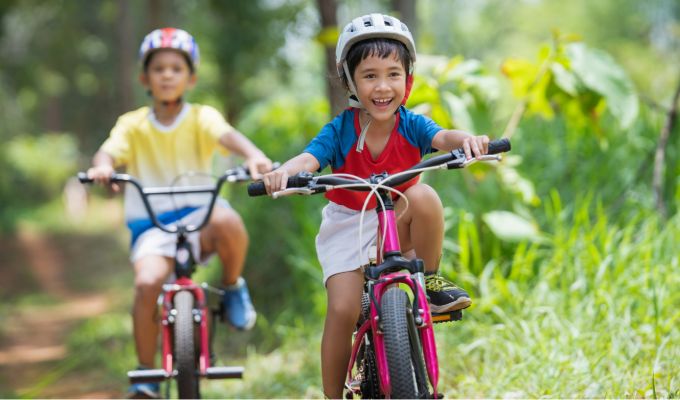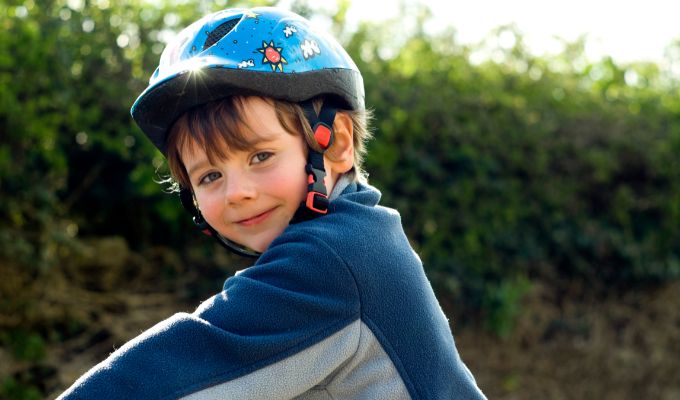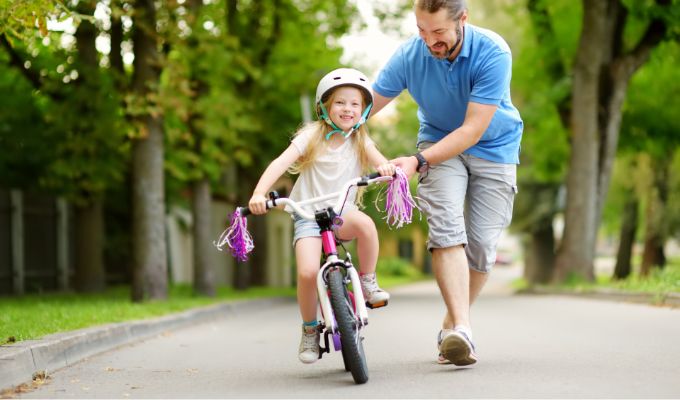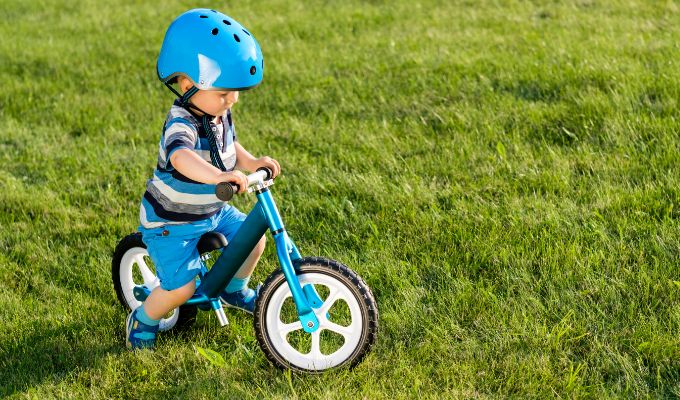Who doesn’t remember their first bike? The bright paintwork, the cool frame, the feeling of freedom when you first rode without training wheels.
Being able to ride a bike means being independent and mobile even as a young person. It’s also great fun and keeps you fit, so parents should get their children a bike as early as possible.
Cycling fosters self-assurance, improves focus, coordination, and dexterity, and is a popular outdoor exercise for many kids. Whether your child is growing into a new bike, or you want to surprise them with a bike for their birthday or Christmas, you need to make sure you’re buying the right size for them to ride safely
Children’s Bike Age and Wheel Size Chart
Children’s bicycles are classified according to wheel size. There are 9, 10, 12, 14, 16, 18, 20, 24 and 26-inch models suitable for children aged two to twelve and young teenagers. The Chart below gives you an idea of the wheel and frame size for children’s age groups, but it is always best to take your child to a bike shop and have them sit on a bike to check the size is the correct fit.
Frame and Wheel Size for Kids children’s bike
| Age Range | Recommended wheel size (in inches) | Height | Frame size |
| 1-3 years | Balance bikes | Under 85cm | – |
| 2-3 years | 10″ – 12″ | 85-105 cm | 18-21 cm |
| 2-6 years | 12″ – 14” | 85-125 cm | 18-32 cm |
| 4-6 years | 16″-18″ | 100-125 cm | 23-32 cm |
| 6-8 years | 20″ | 120-135 cm | 25-34 cm |
| 8-12 years | 24″ | 130-150 cm | 28-35 cm |
| 11-13 years | 26″ | 140-160 cm | 32-38 cm |
Size Criteria
The physical requirements, such as height and leg length, as well as your child’s motor skills, should be taken into consideration before they make their first efforts at riding a children’s bike.
Since age only indirectly reflects specific needs for riding, it is of secondary value. While a balancing bike or scooter is still the ideal option for a four-year-old, switching to a play bike (often a 12-inch children’s bike or 14-inch children’s bike) can make sense for a youngster who is developing early and is under three years old.
Sometimes Thus, a 16-inch child’s bike or even an 18-inch child’s bike might be regarded as the initial entry-level bike for your later-developed but an already tall child. The exact size and inseam length of your child in connection to the specifications of the children’s bike are crucial, so please make sure to compare the details.
Types of bikes and Their Size for Age
Balance Bike
Age: two to five years
Height: less than 85 centimetres
The ideal start to learning: a bike that grows with you
Children and toddlers as young as 2 can learn the fundamentals of cycling on balancing bikes, which is not possible when using training wheels: maintaining balance. Additionally, coordination skills like steering and braking the bike are developed. The bike’s handlebar and saddle heights are adjustable.
Training wheels (stabilizers)
Age: two to six years
Height: –
Many bikes are available with training wheels that can be added as an option for kids between the ages of three and six. However, it is advised to ride without support because they make it impossible to learn how to balance, start, and corner properly and give kids a false sensation of control.
Children’s bikes with 12 – 18 inches
Age: three to six years
Height: 85 to 125cm
The changeover from the balancing bike to the first “real” bicycle with a coaster brake and frequently a front wheel brake, as well as maybe reflectors and a bell, happens here. These (small) kids’ bikes lack any safety features because they aren’t designed for use in traffic on the road. The range of the delivery frequently includes training wheels.
20-inch kids’ bikes
Age: six to eight years
Height: 120 to 135 centimetres
With a gear shift and road-worthy components, these bicycles represent “growing up” in the bicycle community and provide a larger range of functions. The child can now choose specific bike types, like mountain bikes, because it is a full-fledged bicycle now.
24-inch kids bike
Age: eight to twelve years
Height: 130 to 150 centimetres
Bicycles with the same frame design, drivetrain, and brakes as those for adults are now available for youngsters as young as nine. The geometry is the only thing that differs, and it is still child-friendly with features like a sloping top tube and optimization for wheels between 24 and 26 inches.
youth bikes 26-inch youth bikes
Age: over twelve years
Height: 140 to 160cm
These bikes for preteens and teenagers, like the 24-inch cycles before them, are just as well-made and serve the same functions as their adult counterparts. That way, children will be able to simply tag along on lengthier journeys with their guardians.
Should Kids Bikes have Stabilizers?
Similar to a tricycle, the children’s bikes fitted with stabiliser wheels maintain their balance statically.
When using training wheels, children’s naturally occurring and reflexive reaction to adjust their body weight when they feel like they are about to fall or tip over has no bearing on the position or slope of the bike’s curve.
The best thing you can do for a child is to start them on a balance bike as soon as possible, as this will train their balance and coordination for riding a “big bike” when they get older and they won’t need stabilizers.
When riding a bicycle with support wheels, you are in a static balance condition, thus any change in your centre of gravity may seem unsteady and “shaky.” Therefore, the youngster learns to avoid making these compensating movements so that he or she can have the most effective control over the bicycle possible.
Without training wheels, balance must be achieved in a more dynamic manner. Every action has an equal and opposite reaction that must be taken for the model to remain in balance.
The child who is accustomed to the training wheel must retrain the (incorrectly) programmed behaviour before learning to ride a bike with a balanced weight. It’s not impossible, but it’s a lot more work, takes a lot more time, and has a higher risk of causing injuries from falls.
So, our recommendation is to skip the baby steps and start riding without them. Your kid will get the hang of the proper order of pedalling motions in no time.
If the children’s bike or play bike you ordered comes with training wheels, ditch them and put your handy skills to work making a small doll trailer or transfer trailer for your children’s bike instead.
In the near future, we’d like to make sure that, in addition to the training wheels, these producers also provide a stand for the toy bicycles. When the time is right, you’ll recognise it.
Buy Tips for Buying a Kids Bike
For budgetary reasons, parents frequently purchase a larger bike for their growing children so that they can ride it longer. In order for your child to enjoy cycling, they must be able to operate their bicycle securely. Therefore, it is crucial that the wheel be the correct size. Before they can ride a bicycle designed for adults, youngsters typically require three to four wheels.
The bicycle’s weight also plays an impact. Even if lighter bikes are more expensive, they are more enjoyable to ride due to the light weight of the youngster. A 15-kilogram bicycle is tough to ride for a child weighing less than 40 kilogrammes.
Ensure that children enjoy wearing their mandatory (see helmets for children under the age of 12) helmets so that they are willing to wear them.
Cycling gloves and potentially knee pads are adequate for preventing abrasions during the inevitable initial falls.
Bicycling should be entertaining for children. Therefore, it is essential not to put children under strain while they are learning to ride a bicycle, nor to force them to go on tiring trips. Therefore, if your child is comfortable on the bicycle and enjoys riding it, he or she will continue to ride it for the rest of his or her life, and you will be able to embark on a number of wonderful journeys with him or her.



